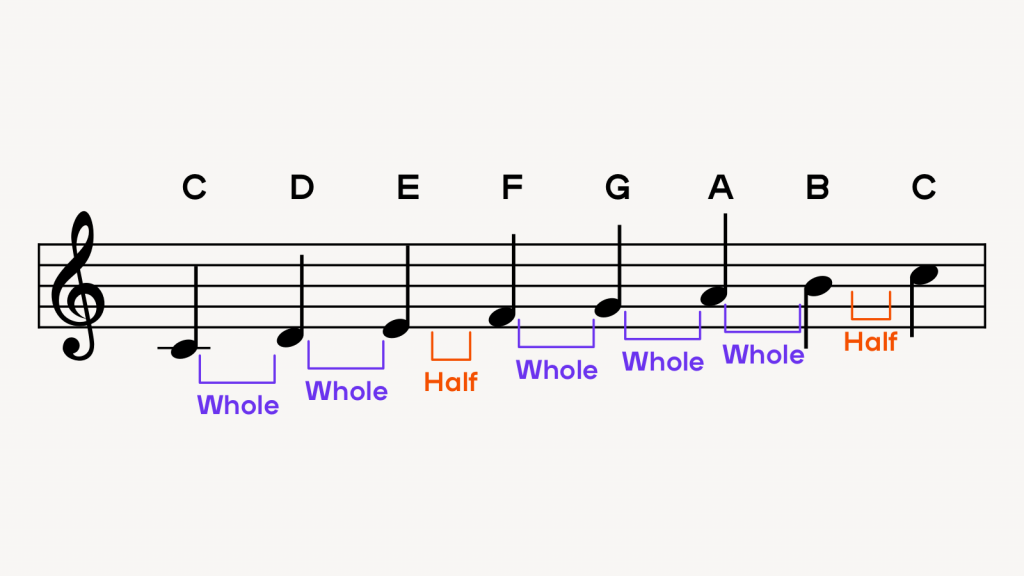Mastering major scales on the piano is essential to understanding the structure of music and improving your playing technique. Our previous post on scales introduced you to 10 crucial piano scales, including major, minor, and chromatic scales. This article will focus exclusively on mastering major scales on the piano.
Major scales are foundational to Western music, forming the backbone for many songs, melodies, and harmonies. Their bright and joyful sound stands in stark contrast to the more melancholic minor scales.
Relationship between scales and keys
In music, the term “key” signifies the central note or tonic of a scale around which a piece is centered. When a song is described as being “in a major key,” its melody and harmony predominantly utilize notes from the relevant major scale. For instance, songs in C Major mainly feature notes from the C Major scale, while those in D Major draw predominantly from the D Major scale.
Major scales on piano for popular songs
Major scales on piano aren’t just academic exercises; they play a foundational role in many beloved pieces of music. Here are some popular songs in major keys to underscore the importance of these scales:
- “Happy” by Pharrell Williams (F Major)
- “Sweet Child o’ Mine” by Guns N’ Roses (D Major)
- “Ode to Joy” from Symphony No. 9 by Ludwig van Beethoven (D Major)
- “Shake It Off” by Taylor Swift (G Major)
- “Viva la Vida” by Coldplay (C Major)
All of the songs listed above are available in the Songs section of the Playground Sessions app.
The structure of a major scale on the piano
Playing every major scale on the piano adheres to a specific pattern of whole and half steps. A “whole step” means moving two keys—counting both white and black—from your starting position, while a “half step” refers to moving just one key.
Major scale pattern: Whole, Whole, Half, Whole, Whole, Whole, Half
By understanding this pattern, you can start on any key and build a major scale. Let’s use this pattern to build a few major scales:
C Major scale on piano
Building the C Major scale on piano
- Start on C — Whole step to D
- D — Whole step to E
- E — Half step to F
- F — Whole step to G
- G — Whole step to A
- A — Whole step to B
- B — Half step to C
- C

D Major scale on piano
Building the D Major scale on piano
- Start on D — Whole step to E
- E — Whole step to F♯ (a black key)
- F♯ — Half step to G
- G — Whole step to A
- A — Whole step to B
- B — Whole step to C♯ (a black key)
- C♯ — Half step to D
- D

E Major scale on piano
For the E Major scale, we’ll begin the sequence, and you can try to complete it yourself.
- Start on E — Whole step to…

I invite you to pick a key on your piano and try constructing a major scale using the above approach. The more you practice, the more intuitive it becomes.
Practicing major scales on piano allows you to learn songs faster since so many songs are in major keys. Familiarity with these scales ensures you’re comfortable with the notes and typical fingerings, enhancing your playing efficiency.
Fingering patterns for major scales on piano
For many major scales on the piano, the standard fingering pattern for the right hand when ascending is 1-2-3-1-2-3-4-5. When descending, it’s 5-4-3-2-1-3-2-1.
Here are some examples:
C Major: Ascending (Right hand): 1-2-3-1-2-3-4-5 Descending (Right hand): 5-4-3-2-1-3-2-1
D Major: Ascending (Right hand): 1-2-3-1-2-3-4-5 Descending (Right hand): 5-4-3-2-1-3-2-1
E Major: Ascending (Right hand): 1-2-3-1-2-3-4-5 Descending (Right hand): 5-4-3-2-1-4-3-2
(1 = Thumb, 5 = Pinky finger. Variations might exist depending on the scale.)
There are other scales, like F and B♭ major, which have their own standard fingerings.
F Major: Ascending (Right hand): 1-2-3-4-1-2-3-4 Descending (Right hand): 4-3-2-1-4-3-2-1
B♭ Major: Ascending (Right hand): 2-1-2-3-1-2-3-4 Descending (Right hand): 4-3-2-1-3-2-1-2
So while we always use the same 5 fingers, the patterns or sequences in which we use them can vary based on the scale.
The importance of practicing major scales for piano players
Scales are more than just sequences of notes; they’re foundational to the development of any pianist. Here’s why practicing scales is crucial:
- Finger Strength and Agility: Regular scale practice builds strength and dexterity in the fingers, enabling fluid movement across the keyboard.
- Technique: Practicing scales refines hand positioning, fingering, and touch, ensuring a better playing technique.
- Ear Training: Through scales, players can familiarize themselves with the sound of different sequences, aiding in pitch recognition and melody creation.
- Musical Foundation: Scales form the backbone of chords, melodies, and harmonies, equipping players with the tools they need for composition and improvisation.
By understanding and consistently practicing these major scales on piano, pianists lay a strong foundation for more advanced concepts and techniques. So, dive in, practice regularly, and watch your musical journey flourish!

